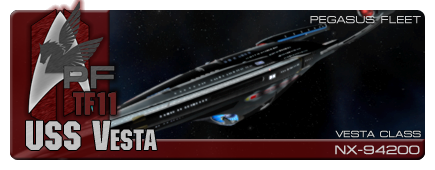Difference between revisions of "Portal:Simulations/Featured"
m |
|||
| (2 intermediate revisions by the same user not shown) | |||
| Line 1: | Line 1: | ||
| − | [[Image: | + | [[Image:Vesta.png|right]]The '''USS ''Vesta'' (NX-94200)''' is a {{Class|Vesta}} starship commissioned in 2386 under the command of [[Captain]] [[Emily Quinn]]. She is the first starship to bear the name, as well as the first ship of her class. The ''Vesta'' was designed in response to the [[Quantum Slipstream Drive|quantum slipstream drive]] brought back by the '''USS ''Voyager'' ''' in 2377. |
| − | + | Following the end of the [[Dominion War]], devastating ship losses required Starfleet to recuperate. Instead of rebuilding the fleet with aging designs, Starfleet R&D instead focused on the introduction of new designs, expanding on the existing technology. But the new design push also spread to development of new technology. The return of the '''USS ''Voyager'' ''' in 2377 brought a treasure trove of new technology, most of it barely tested. The [[Quantum Slipstream Drive|quantum slipstream drive]], discovered by the ''Voyager'' in 2374 and tested early the next year proved to be unstable. Starfleet engineers studied the slipstream data and attempted to improve on the design. While early trials and simulations seemed promising, the only way to prove the design worked was to incorporate it into a complete testbed vessel. | |
| − | + | This led to the development of the {{Class|Vesta}} starship. The first of her class, the '''USS ''Vesta'' (NX-94200)''', was herald as the '''Next Great Experiment''', similar to the '''USS ''Excelsior'' ''' from a century before. Similar in size to the {{Class|Sovereign}}, the ''Vesta'' was a [[Ship-of-the-Line]], capable of performing a multitude of different missions. Following initial shakedowns, the ''Vesta'' was assigned to the [[Eleventh Fleet]]. There she resupplied at [[Starbase 332]], and under the supervision of [[Commodore]] [[Emily Quinn]] began [[Quantum Slipstream Drive|slipstream]] trials away from civilized areas. | |
| − | [[USS | + | [[USS Vesta|Read more...]] |
<noinclude>[[Category:Pegasus Fleet Portals]]</noinclude> | <noinclude>[[Category:Pegasus Fleet Portals]]</noinclude> | ||
Revision as of 02:02, 15 January 2012
Following the end of the Dominion War, devastating ship losses required Starfleet to recuperate. Instead of rebuilding the fleet with aging designs, Starfleet R&D instead focused on the introduction of new designs, expanding on the existing technology. But the new design push also spread to development of new technology. The return of the USS Voyager in 2377 brought a treasure trove of new technology, most of it barely tested. The quantum slipstream drive, discovered by the Voyager in 2374 and tested early the next year proved to be unstable. Starfleet engineers studied the slipstream data and attempted to improve on the design. While early trials and simulations seemed promising, the only way to prove the design worked was to incorporate it into a complete testbed vessel.
This led to the development of the Vesta-class starship. The first of her class, the USS Vesta (NX-94200), was herald as the Next Great Experiment, similar to the USS Excelsior from a century before. Similar in size to the Sovereign-class, the Vesta was a Ship-of-the-Line, capable of performing a multitude of different missions. Following initial shakedowns, the Vesta was assigned to the Eleventh Fleet. There she resupplied at Starbase 332, and under the supervision of Commodore Emily Quinn began slipstream trials away from civilized areas.



